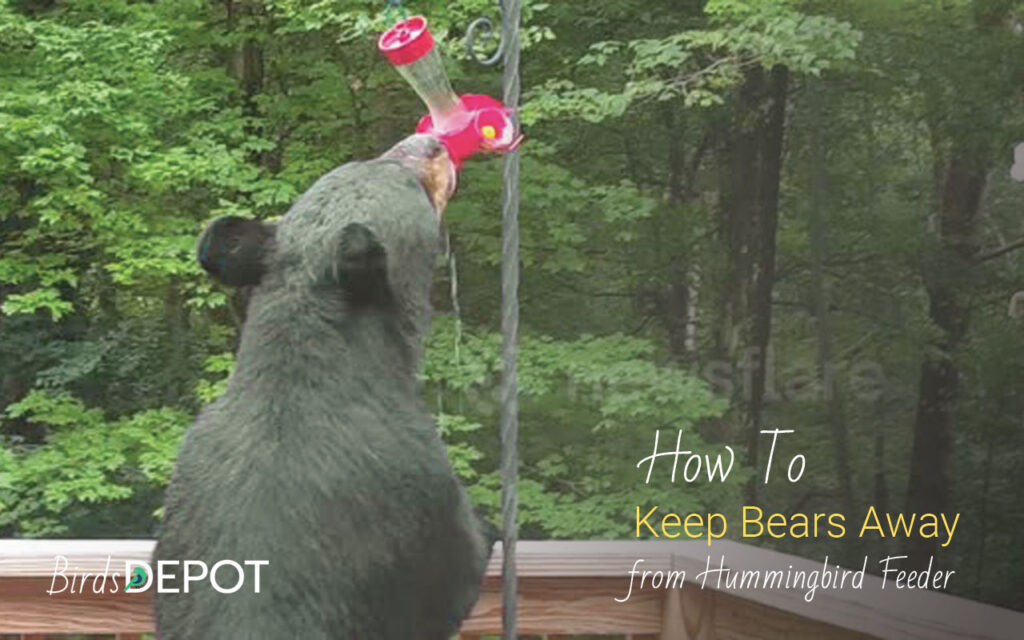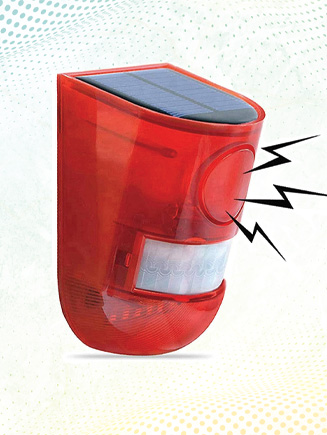As bird enthusiasts, there’s nothing more delightful than watching hummingbirds flutter around our gardens and balconies. These tiny, iridescent creatures bring life and beauty to any outdoor space. Placing hummingbird feeders and filling them with nectar is the best way to attract hummingbirds. But what happens when your hummingbird drinks start attracting unexpected visitors, such as black bears?
This article will explore effective strategies to keep bears away from hummingbird feeders, ensuring a safe and enjoyable environment for birds and humans.

Do Hummingbird Feeders Attract Bears?
Yes, hummingbird feeders can attract bears. Bears have an acute sense of smell and are drawn to food sources, including sweet substances like sugar water in hummingbird feeders. When bears detect the scent of sugar water, they may investigate the source, leading to bear encounters with hummingbird feeders. This can pose risks to both property and safety, as bears may damage feeders or become aggressive in their search for food. Therefore, bird enthusiasts need to take precautions to minimize the likelihood of attracting bears to hummingbird feeders.
Why Are Bears Interested in Hummingbird Feeders?
- Bears have a sweet tooth, and nectar provides a quick energy boost, crucial for survival.
- During spring and summer, bears consume over 5,000 calories a day, and hummingbird feeders offer an easy source of sustenance.
- The concentrated sugar water in hummingbird feeders provides a high-calorie meal for bears.
- Hanging feeders are like fast-food drive-thrus for bears, requiring minimal effort to access.
Effective Strategies to Keep Bears Away
Discard the Leaky Feeder
Regularly inspect your feeders for leaks. Leaky containers spill nectar, which can attract hungry bears. Replace damaged or leaky feeders promptly or fix any leaky feeder.
Hang Feeders Appropriately
Hanging feeders high enough on tall poles positioned away from trees or fences can help keep them out of reach of curious bears. Additionally, implementing bear-proofing measures, such as installing baffles or barriers, ensures that bears cannot climb the poles to reach the feeders. Choosing metal poles with smooth surfaces and minimal footholds further deters bears as they struggle to grip slick surfaces. By combining these tactics, bird enthusiasts can create a safer environment for hummingbirds while minimizing the risk of bear encounters.
Pick Fruit On Time
It’s important to be mindful of ripe fruit on nearby fruit trees, as it can also attract bears. Bears have a remarkably keen sense of smell and can detect the scent of ripe fruit from a considerable distance away. To prevent bear visits, it’s essential to harvest ripe fruit from trees in the vicinity promptly. Doing so can reduce the likelihood of bears being drawn to our property in search of a snack.
Use Spice and Lemon
Consider using natural repellents such as cayenne pepper, cinnamon, and lemon-scented cleaning products to deter bears from approaching hummingbird feeders. Black Bears dislike strong scents, so sprinkling cayenne pepper around the feeder or incorporating cinnamon can help discourage them from investigating the area. Cleaning the feeders with lemon-scented products adds another layer of bear deterrent, as bears are sensitive to citrus scents.
Clean Up
Regularly cleaning spilled nectar and debris around the feeder is essential for deterring grizzlies. Bears are less likely to return to a feeding area if there’s no leftover food. By promptly cleaning up spilled nectar and removing debris, we eliminate potential attractants that could draw bears to our hummingbird feeders.
Securely Mount Feeders
Proper installation is key to keeping hummingbird feeders out of reach for bears. Mount feeders on sturdy poles or hanging systems, ensuring they are at least 10 feet above the ground and away from trees or structures that bears could climb.
- Use a long feeder pole, which creates an obstacle to reaching the bear near feeders. Also, it is easy to refill. You can follow the article to learn more about a bear-proof pole.
- Hang the feeder on at the high tree branch. You can follow the pulley method to easily hang and refill the feeder in high tree branches.
Remove Feeders at Night
Bears are active at night. To avoid attracting bears during their most active feeding times, consider taking down hummingbird feeders and storing them indoors until the following morning. This simple step can help prevent unwanted visits.
Keep bird feeders empty during bear season
According to DEC, you should avoid hanging hummingbird feeders along with other feeders by April 1 and resume on November 30 if you live in a heavy bear traffic area.
If you live in an area where bears attack occurs in feeders, you will notice that bears attack feeders at a certain time of the year. The rest of the time is known as hibernation. Generally, bears are out from the hibernation period from mid-March to mid-November.
Plant flowers
If you need to take down the nectar feeders and find a new way to attract hummingbirds to your yard, consider planting native flowers. Hummingbirds are generally attracted to red flowers, so planting native flower plants that easily attract birds can be a great way to invite them into your yard.
You can also hang flower baskets on your deck or patio, attracting hummingbirds but keeping the bears away.
Place Birdbath
Another way to attract hummingbirds by avoiding beers is a birdbath. If you put a hummingbird bird bath in your yard, it easily grabs their attention in your yard. Also, you will watch their bathing and how beautifully they sip water from the birdbath.
Use fence
Though bears are good climbers, you can minimize their presence by introducing fences around your properties. Try to make the fence 6 feet high, and a metal fence will be a good option, as it is sturdy and helps withstand bear attacks.
Use Airhorns
Install motion-activated airhorns near the feeder on the ground. This way, the airhorns will only activate when large animals are nearby. Small birds above the ground will not trigger the device. The sudden noise and bright light from Motion-activated lights or sounds startle them and encourage them to seek snacks elsewhere. Though these noises will not appeal to you, they are ideal for the safety of your house.
Also, the method is effective even when bears are out from hibernation.
Sugar Shaker Nectar Maker
Solar Sound & Light Alarm Motion Sensor
You can use the Solar Sound & Light Alarm Motion Sensor for this. The good part of the sensor is that it is solar-powered. So, you do not need to worry about running out of batteries.
You can customize the alarm setting according to your preference. The good part is that it comes with two options: light and sound. So, if you prefer a quieter thing, you can only use the light.
Educating Others
Check with your local wildlife office to learn when bears are active in your area. Spreading awareness about bear activity, safety, and responsible bird-feeding practices is crucial to mitigating bear encounters. Share tips and strategies with neighbors, friends, and local birdwatching communities to promote bear awareness and safety in residential areas.
Other Animals Attracted to Hummingbird Feeders
In addition to bears, it’s important to keep an eye out for a variety of other animals that may visit hummingbird feeders, including raccoons, bats, squirrels, bees, and other birds. Raccoons are known for their dexterous paws and may attempt to raid feeders for food. Bats, attracted to the sugary contents of feeders, may visit during dusk or dawn hours. Squirrels are agile climbers and may attempt to access feeders, particularly if they contain nuts or seeds. Bees are attracted to the sweet nectar and may swarm around feeders, posing a nuisance to hummingbirds.
Additionally, other birds may visit feeders to feed or engage in territorial disputes with hummingbirds. By remaining vigilant and taking appropriate precautions, such as using squirrel-proof feeders and bee guards, we can help ensure a safe and enjoyable feeding environment for hummingbirds while minimizing conflicts with other wildlife.
Implementing these strategies allows you to enjoy watching hummingbirds without inadvertently inviting furry neighbors. Responsible feeder management benefits both wildlife and humans. So, let’s create a harmonious space where birds thrive and bears find their meals elsewhere.
